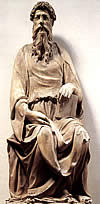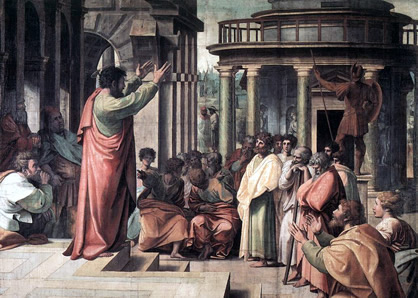Biblical Persons Asia Minor Saint John
Saint John

John the Apostle was the son of Zebedee, and the brother of James. One
tradition gives his mother's name as Salome. They originally were
fishermen and fished with their father in the Lake of Genesareth. He was
first a disciple of John the Baptist and later one of the twelve
disciples of Jesus. He is revered as a saint by most of Christianity.
The Roman Catholic Church commemorates him on December 27. He is also
remembered in the liturgy on January 3. The Eastern Orthodox Church
commemorates him on September 26, and also remembers him on May 8, on
which date Christians used to draw forth from his grave fine ashes which
were believed to be effective for healing the sick.
John had a prominent position in the Apostolic body. Peter, James and
John were the only witnesses of the raising of Jairus' daughter (Mark
5:37), of the Transfiguration (Matthew 17:1) and of the Agony in
Gethsemane (Matthew 26:37). Only he and Peter were sent into the city to
make the preparation for the final Passover meal (the Last Supper) (Luke
22:8). At the meal itself, his
 place
was next to Jesus on whose chest he leaned (John 13:23, 25). According
to the general interpretation, John was also that "other disciple" who
with Peter followed Jesus after the arrest into the palace of the
high-priest (John 18:15). John alone remained near Jesus at the foot of
the cross on Calvary with Jesus mother, Mary, and the pious women and
took Mary into his care as the last legacy of Jesus (John 19:25-27).
After the Resurrection, John with Peter was the first of the disciples
to run towards the grave and he was the first to believe that Jesus had
truly risen (John 20:2-10). John was accustomed to indicate himself in
writing without giving his name as: "the disciple whom Jesus loved".
After Jesus Ascension and the descent of the Holy Spirit, John took,
together with Peter, a prominent part in the founding and guidance of
the church. He is with Peter at the healing of the lame man in the
Temple (Acts 3:1 seq.). With Peter he is also thrown into prison (Acts
4:3). He is also with Peter visiting the newly converted in Samaria
(Acts 8:14).
place
was next to Jesus on whose chest he leaned (John 13:23, 25). According
to the general interpretation, John was also that "other disciple" who
with Peter followed Jesus after the arrest into the palace of the
high-priest (John 18:15). John alone remained near Jesus at the foot of
the cross on Calvary with Jesus mother, Mary, and the pious women and
took Mary into his care as the last legacy of Jesus (John 19:25-27).
After the Resurrection, John with Peter was the first of the disciples
to run towards the grave and he was the first to believe that Jesus had
truly risen (John 20:2-10). John was accustomed to indicate himself in
writing without giving his name as: "the disciple whom Jesus loved".
After Jesus Ascension and the descent of the Holy Spirit, John took,
together with Peter, a prominent part in the founding and guidance of
the church. He is with Peter at the healing of the lame man in the
Temple (Acts 3:1 seq.). With Peter he is also thrown into prison (Acts
4:3). He is also with Peter visiting the newly converted in Samaria
(Acts 8:14).
There is no positive information concerning the duration of this
activity in Judea. Apparently, John in common with the other Apostles
remained some 12 years in this first field of labour, until the
persecution of Herod Agrippa I led to the scattering of the Apostles
through the various provinces of the Roman Empire (cf. Acts 12:1-17). It does not appear improbable
that John then went for the first time to Asia Minor and exercised his
Apostolic office in various provinces there. In any case a messianic
community was already in existence at Ephesus before Paul's first
labours there (cf. "the brethren", Acts 18:27, in addition to Priscilla
and Aquila) and it is easy to connect a sojourn of John in these
provinces with the fact that the Holy Spirit did not permit Paul on his
second missionary journey to proclaim the Gospel in Asia, Mysia and
Bithynia (Acts 16:6 sq.). Such a sojourn by John in Asia in this first
period was neither long nor uninterrupted. He returned with the other
disciples to Jerusalem for the Apostolic Council (about A.D. 51). Paul
in opposing his enemies in Galatia names John explicitly along with
Peter and James the Just as a "pillar of the Church" and refers to the
recognition that his Apostolic preaching of a gospel free from the law
received from these three, the most prominent men of the messianic
community at Jerusalem (Galatians 2:9).
of the Roman Empire (cf. Acts 12:1-17). It does not appear improbable
that John then went for the first time to Asia Minor and exercised his
Apostolic office in various provinces there. In any case a messianic
community was already in existence at Ephesus before Paul's first
labours there (cf. "the brethren", Acts 18:27, in addition to Priscilla
and Aquila) and it is easy to connect a sojourn of John in these
provinces with the fact that the Holy Spirit did not permit Paul on his
second missionary journey to proclaim the Gospel in Asia, Mysia and
Bithynia (Acts 16:6 sq.). Such a sojourn by John in Asia in this first
period was neither long nor uninterrupted. He returned with the other
disciples to Jerusalem for the Apostolic Council (about A.D. 51). Paul
in opposing his enemies in Galatia names John explicitly along with
Peter and James the Just as a "pillar of the Church" and refers to the
recognition that his Apostolic preaching of a gospel free from the law
received from these three, the most prominent men of the messianic
community at Jerusalem (Galatians 2:9).
Of the other New Testament writings, it is only from the three Letters
of John and the book of Revelation that anything further is learned
about John. Both the Letters and Revelation presuppo se
that John belonged to the multitude of personal eyewitnesses of the life
and work of Jesus (cf. especially 1 John 1:1-5; 4:14), that he had lived
for a long time in Asia Minor, was thoroughly acquainted with the
conditions existing in the various messianic communities there, and that
he had a position of authority recognized by all messianic communities
as leader of this part of the church. Moreover, Revelation says that its
author was on the island of Patmos "for the word of God and for the
testimony of Jesus", when he was honoured with the heavenly vision
contained in Revelation (Revelation 1:9).
se
that John belonged to the multitude of personal eyewitnesses of the life
and work of Jesus (cf. especially 1 John 1:1-5; 4:14), that he had lived
for a long time in Asia Minor, was thoroughly acquainted with the
conditions existing in the various messianic communities there, and that
he had a position of authority recognized by all messianic communities
as leader of this part of the church. Moreover, Revelation says that its
author was on the island of Patmos "for the word of God and for the
testimony of Jesus", when he was honoured with the heavenly vision
contained in Revelation (Revelation 1:9).
John is traditionally held to be the author of five books of the New
Testament, including the Gospel of John. However, almost all higher
critical scholars place the writing of the final edition of John at some
time in the late first or early second century. Catholic/Orthodox
tradition says that he and the Virgin Mary moved to Ephesus, where both eventually died. Many
Evangelical and other scholars question this, especially due to the
advanced age which Mary would have reached by this time. Some believe,
however, that there is support for the idea that John did go to Ephesus
and from there wrote the three epistles tradition attributed to him.
John was allegedly banished by the Roman authorities to the Greek island
of Patmos, where some believe that he wrote the Book of Revelation.
According to Tertullian (in The Prescription of Heretics) John was
banished (presumably to Patmos) after being plunged into boiling oil in
Rome and suffering nothing from it. Some believe his tomb is located at
Selcuk, a small town in the vicinity of Ephesus.
the Virgin Mary moved to Ephesus, where both eventually died. Many
Evangelical and other scholars question this, especially due to the
advanced age which Mary would have reached by this time. Some believe,
however, that there is support for the idea that John did go to Ephesus
and from there wrote the three epistles tradition attributed to him.
John was allegedly banished by the Roman authorities to the Greek island
of Patmos, where some believe that he wrote the Book of Revelation.
According to Tertullian (in The Prescription of Heretics) John was
banished (presumably to Patmos) after being plunged into boiling oil in
Rome and suffering nothing from it. Some believe his tomb is located at
Selcuk, a small town in the vicinity of Ephesus.
When John was old he trained Polycarp, later Bishop of Smyrna. This was
important because Polycarp was able to carry John's message to another age. In art, John
as the presumed author of the Gospel is often depicted with an eagle,
which symbolizes the height he rose to in the first chapter of his
gospel.
Polycarp was able to carry John's message to another age. In art, John
as the presumed author of the Gospel is often depicted with an eagle,
which symbolizes the height he rose to in the first chapter of his
gospel.
Important Biblical Personalities
Saint Paul
Saint Peter
Saint Barnabas
Saint John
Saint Titus
Saint Timothy
Saint Barbara
Saint Nicholas
Saint Polycarp
Saint Helen
Saint Silas
Saint Margaret
Saint Blaise
Saint Philip
Saint Thecla
Saint Jacob
Saint Basil
Saint Ephraem
Virgin Mary
Saint Gregory Nazianzen
Saint Gregory of Nyssa
Saint Gregory the Illuminator
Constantine The Great


